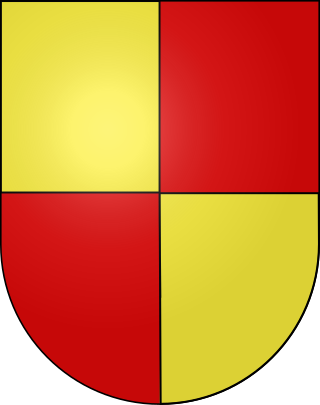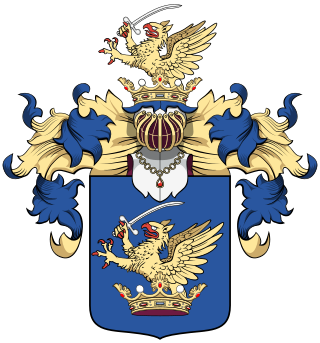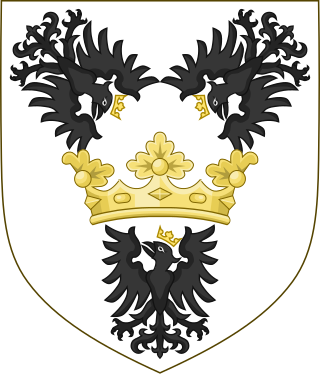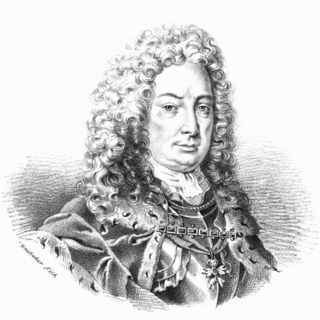
The Waldersee family is an old German noble family, representing illegitimate branch of the House of Anhalt-Dessau.

The House of Festetics or Feštetić is the name of a historic noble family of Hungarian counts and princes which dates back to 15th century. A prominent family during the Austro-Hungarian Empire, they are mostly known for the baroque Festetics Palace and the Viennese Prince Tasziló Festetics.

Prince Hans Ulrich von Eggenberg was an Austrian statesman, a son of Seyfried von Eggenberg, Lord of Erbersdorf (1526–1594), and great-grandson of Balthasar Eggenberger. He was a prominent member of the House of Eggenberg and gained the title of Duke of Krumau.

Ehrenhausen is a former municipality in the district of Leibnitz in Styria, Austria. Since the 2015 Styria municipal structural reform, it is part of the municipality Ehrenhausen an der Weinstraße.

Baroness Wilhelmine Caroline Christiane Henriette of Dörnberg, was a member of the House of Dörnberg and a Baroness of Dörnberg by birth. Through her marriage to Maximilian Karl, 6th Prince of Thurn and Taxis, Wilhelmine was also a member of the House of Thurn and Taxis. Wilhelmine was known to her family and friends as "Mimi."

The Banffy family is an ancient Hungarian noble family, whose members occupied many important political positions in the Kingdom of Hungary and later within the Austro-Hungarian Empire.

Ruprecht Freiherr von Eggenberg was an Austrian nobleman, landowner and Colonel-general from the Duchy of Styria in Inner Austria, then part of the Holy Roman Empire.

The House of Eggenberg was the name of an influential Austrian noble family from Styria, who achieved princely rank in the 17th century. The family's last male heir died in 1717, bringing an end to the House of Eggenberg.

The House of Taxis-Bordogna und Valnigra is the name of an old Austro-Italian noble family whose members held the position of Imperial Hereditary Postmaster. The family was formed by the descendants of Elisabeth von Taxis and her husband Bonus von Bordogna. Elisabeth Taxis was a sister of the Brussels Postmaster General Johann Baptista of Taxis (1470–1541), the ancestor of the Princely House of Thurn and Taxis.

Giovanni Pietro de Pomis was an Italian painter, medailleur, architect and fortress master builder. His works show a marked influence of late-Mannerism.

Maximilian Freiherr von und zu Trauttmansdorff, was an Austrian politician and diplomat of the Thirty Years' War era. His other titles included Freiherr von Gleichenberg, Neuenstadt am Kocher, Negau, Burgau und Totzenbach, Herr zu Teinitz. He was a Knight in the Order of the Golden Fleece, Geheimer Rat, Chancellor and Obersthofmeister.

Ferdinand Joseph, Prince of Dietrichstein, was a German prince member of the House of Dietrichstein, 3rd Prince (Fürst) of Dietrichstein zu Nikolsburg, Princely Count of Tarasp, Baron (Freiherr) of Hollenburg, Finkenstein and Thalberg; in addition, he served as Lord Chamberlain (Obersthofmeister), Conference Minister (Konferenzminister) and Privy Councillor (Geheimrat) of Emperor Leopold I, and Knight of the Order of the Golden Fleece since 1668.

Maximilian, Prince of Dietrichstein, was a German prince member of the House of Dietrichstein, Imperial Count (Reichsgraf) of Dietrichstein and owner of the Lordship of Nikolsburg in Moravia; since 1629 2nd Prince (Fürst) of Dietrichstein zu Nikolsburg, Baron (Freiherr) of Hollenburg, Finkenstein and Thalberg, was a diplomat and minister in the service of the House of Habsburg. He was a Kämmerer, Lord Chamberlain (Obersthofmeister), Conference Minister (Konferenzminister) and Privy Councillor of Emperors Ferdinand II and Ferdinand III, Knight of the Order of the Golden Fleece since and ruler over Nikolsburg, Polná, Kanitz, Leipnik, Weisskirch and Saar.

Walther Franz Xaver Anton, Prince of Dietrichstein, was a German prince member of the House of Dietrichstein, 5th Prince (Fürst) of Dietrichstein zu Nikolsburg, Princely Count of Tarasp, Baron (Freiherr) of Hollenburg, Finkenstein and Thalberg.

Franz Joseph, Prince of Dietrichstein, was a German prince, member of the House of Dietrichstein, Major general, 8th Prince (Fürst) of Dietrichstein zu Nikolsburg, Count of Proskau-Leslie, Baron (Freiherr) of Hollenburg, Finkenstein and Thalberg.

Joseph Franz, Prince of Dietrichstein, was a German prince, Major general, 9th Prince (Fürst) of Dietrichstein zu Nikolsburg, Count of Proskau-Leslie, Baron (Freiherr) of Hollenburg, Finkenstein and Thalberg.

Nikolaus VI Graf Pálffy von Erdőd was a Hungarian nobleman, Imperial Field marshal and Palatine of Hungary.

The Gudenus family is a prominent German noble family, originating in Hesse, Germany, whose ancestry can be traced back to the 16th century.


















